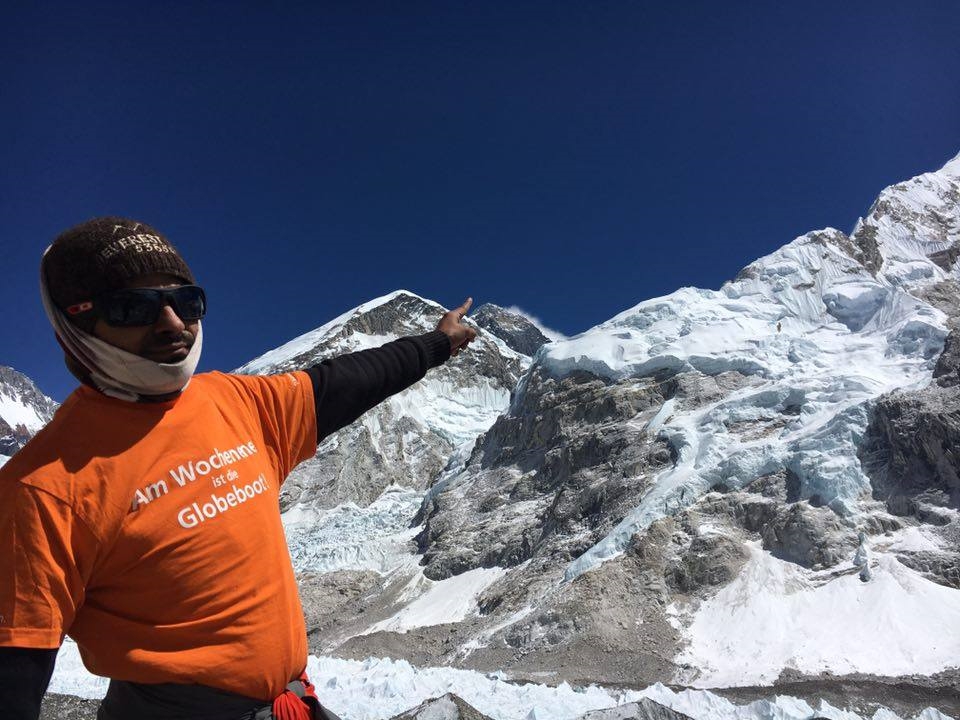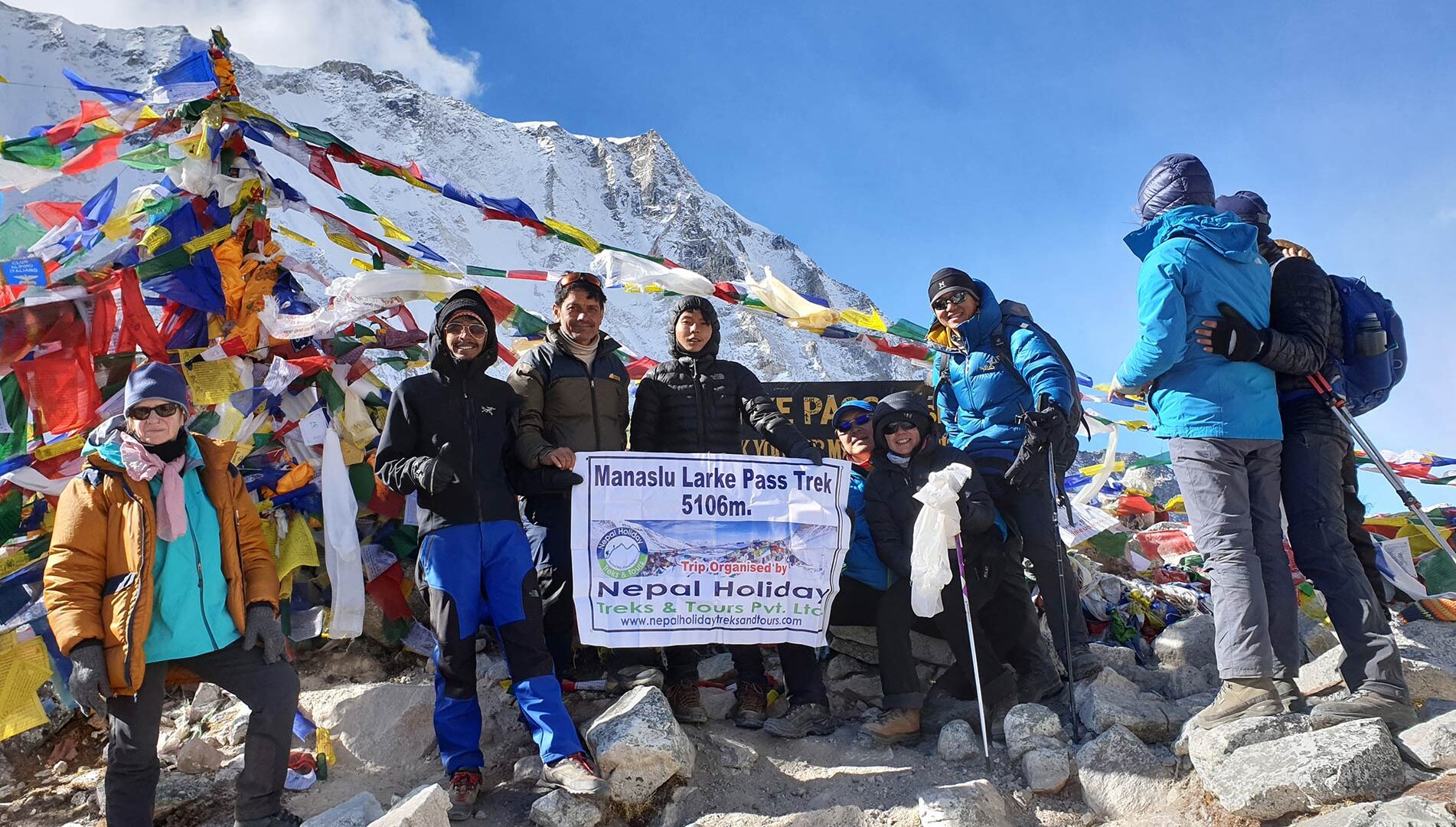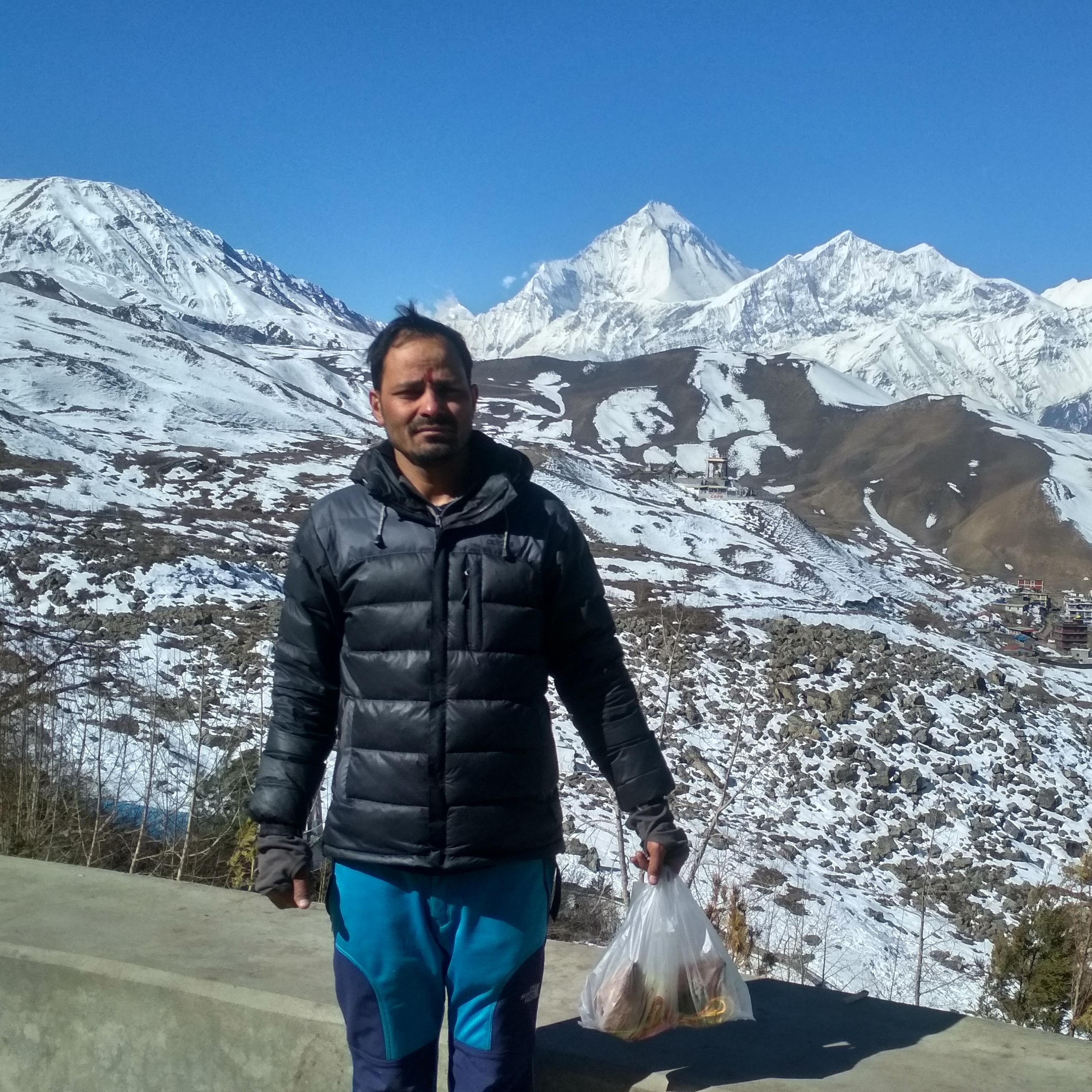Manaslu Larke Pass Trek
Manaslu Larke Pass Trek Highlights
- Rich culture and genuine effort surround the 8,156-meter-high Mount Manaslu.
- The eighth-highest peak in the world is Mount Manaslu which is located inside the Manaslu Conservation area to the east of Annapurna.
- Experience to views fom Larke Pass (5160 meters).
Manaslu Larke pass Trek is one of the most difficult trekking routes in western Nepal, began accepting foreigners in 1991. The Manaslu Region is known for its exceptional trekking routes that offer breathtaking views of the mountains and the distinct culture that surrounds Mount Manaslu.
The eighth-highest peak in the world is Mount Manaslu. You can encounter a great diversity of flora, landscapes, and customs here. You will also cross several rivers on this Manaslu trek, including the Budi Gandaki, Machha, Tharo, Deng, and Ghatta Kholas. Additionally, you can take in the breathtaking views of numerous mountain peaks, including Manaslu, Himal Chuli, the Ganesh Himal Range, and other Himalayan Range mountains.
The Gurung and Tibetan cultures, waterfalls, ancient Buddhist monasteries and stupas, lovely ethnic villages, and verdant forests with rhododendron, blue pine, and bamboo, among other trees, are the trek’s main draws. The area is also home to a variety of plants and animals, such as ravens, pheasants, deer, pika, and Himalayan marmots. The Manaslu region’s trekking trail passes through a number of charming small villages home to a variety of ethnic groups. In this region live the Gurung and Tamang people.
Manaslu Trekking is close to the border between Tibet and Nepal, so a special permit is required to enter the area and enjoy the breathtaking circuit trek. This permit is readily obtained from a Nepali trekking company that is officially registered with the government. The well-known Himalayan Mountains are home to a diverse range of cultures, stunning views of high-altitude glacier lakes, and unusual flora and fauna.
Larke Pass (5231m)
Larke Pass (5213 m) is the main draw for hikers doing the Manaslu Larke pass. Among the hardest trekking passes is this one. Views of Annapurna II, Kangguru Himal, Himlung Himal, and Manaslu are available from this location. The Manaslu region offers a range of trekking options as well, including the Manaslu Circuit Trek, Base Camp Trek, Larke Pass Trek, and Tsum Valley Trek. If you’re thinking about trekking here and want to wait for the best time, September through May are thought to be good trekking months.
Thus, don’t forget to register with Visit Mount Treks and Tours if you’re eager to explore rural Nepal and want to create memories in the shadow of the Himalayas. We will offer you very skilled and knowledgeable porters and guides for your needs. We will also assist you in setting up effective networking in the Himalayan regions and in making permit and TIMS arrangements. So, take part in some exhilarating adventures in Nepal’s rural areas.
Best time to visit
The Manaslu Larke Pass trek varies significantly based on the climate zone as well. Thus, being aware of the temperature and climate of the Manaslu Larke Pass trek will enable you to have a comfortable trekking experience. The reason for this is that climbing and trekking are impacted by the weather.
Spring (March, April and May)
The beginning of new chapters, the area seems as if it’s come back to life. The frozen lakes start to defrost, streams begin to fill up, new buds are seen sprouting, and villagers gradually begin to return.
Spring is the safest season for the Manaslu Larke Pass trek due to its low risk of landslides, avalanches, and other weather hazards. The weather condition is mild to cold.
Autum (September, October and November)
Autum is the festive season in Nepal when one of Dashain and Tihar’s major celebrated around the country. The season start with fresh and pleasant air as monsoon rain has washed away all the pollution. The temperature is also stable with mild weather conditions.
The warm climate and clear skies make it the best time to visit Manaslu Larke Pass trek for active trekkers.
Winter (December, January and February)
These are the months of snowfall, so crossing Larke Pass will be a challenging for trekkers. Winter is the icy-cold season of the year, but the lower region trek is entirely enjoyable at this time.
Monsoon (June, July and August)
The luscious and dense forest becomes vibrant green due to the monsoon rain. Due to continuous rain showers, the paths are slippery, muddy, and bring the presence of several leeches and bugs. Trekking during this month is for adventure seekers and nature lovers.
People and Culture
There are many different kinds of people living in the Manaslu region. This is where the Shah dynasty began. Now, though, the Gurung people make up the majority of the population. The area is also inhabited by the Nubri and Tsum ethnic groups. One of the traditional dishes of the Tsum ethnic group is mohi chop. It’s a mixture of chili, garlic, salt, and either skimmed milk or Mohi. They also like Sukuti, a dried meat dish made mostly of buffalo. The two most prevalent religions in the Manaslu area are Tibetan Buddhism and Bon po (animism). Being a historically rich area, many of the festivals observed here have religious connotations and are attended by a large number of devout religious individuals. The Tsum Shagya Centennial Festival commemorated the nonviolent custom of Tsum valley, which dates back a century.
Foods and Accommodations
The teahouses offer single rooms with attached bathrooms at lower altitudes. However, the facilities get fewer as you ascend. Most rooms have a twin-sharing bathroom and a shared one. Two beds with mattresses, pillows, and cozy blankets are present in a room.
The cuisine in the Manaslu region is very varied and can be easily tailored to your preferences. In teahouses, we can order continental, Italian, Tibetan, and Nepali cuisine in addition to our usual fare. Since all of the food will be prepared by a local chef using vegetables from the area, it will have a very distinctive flavor.
Guide and Porter
According to Nepal tourism board, all the trekkers are required to obtain services of licensed trekking guide and to obtain TIMS card through authorized trekking agencies registered with the government of Nepal. So, it’s always recommended to trek with experienced trekking licensed guide to ensure safety and utilize your valuable time in a best way. We will provide you experienced licensed guide with their insurance and excellence in safety performance.
Travel Insurance
Purchasing travel insurance prior to embarking on a Manaslu Larke Pass trek is highly advised. Verify that accidents that occur in high altitudes or overseas are covered by your insurance. While we make every effort to look after you, accidents happen occasionally and are beyond our control. Therefore, having insurance is ideal in the event of a medical emergency requiring a helicopter evacuation.
Altitude Sickness
You might experience symptoms like nausea, headaches, dyspnea, elevated heart rate, and uneasiness when rapidly ascending. Additionally, if the symptoms last longer than expected, your body may not have been able to withstand the altitude change. Thus, kindly inform your group and your guide if you experience any of these symptoms. You will receive first aid right away from your guide.
Here are some tips to reduce your risk of altitude sickness:
Stop and rest where you are
- Make sure you are drinking enough water
- Do not go any higher for at least 24 to 48 hours
- Do not smoke, drink alcohol, or exercise
- Eating foods and drinking fluids that contain carbs such as bread, pasta, fruits, milk, rice, and so on.
Permits for Manaslu Larke Pass trek
You will need two permits to trek in the Manaslu region. They are:
- Manaslu Restricted Area permit
- Annapurna Conservation Area permit
Manaslu Larke Pass Trek Itinerary
Drive from Kathmandu to Machha Khola
Trek from Machha Khola to Jagat (22 km, 7-8 hr walk)
Trek from Jagat to Dyang (20 km, 6-7 hr walk)
Trek From Dyang to Ghap (12 km, 5-6 hr walk)
Trek from Ghap to Lo-Gaon ( 15 km, 4-5 hr walk)
Trek from Lo-Gaon to Sama Gaon (16.4 km, 5-6 hr walk)
Rest Day at Sama-Gaon
Trek From Sama-Gaon to Sambo (16.9 km, 5-6 hr walk)
Trek from Sambo to Dharmasala Larke Phedi (11.7 km, 4-5 hr walk)
Trek from Larke-La to Bhimthangt (24.6 km, 8-9 hr walk)
Trek from Bhimthang to Gho (14 km, 5-6 hr walk)
Trek from Gho to Dharapani (12 km, 4-5 hr walk)
Drive to Kathmandu via Besisahar Lamjung From Dharapani
Manaslu Larke Pass Trek Inclusions
What's included
- Three times meals a day- Breakfast, Lunch, Dinner and accommodation in tea house/ lodge during the trek
- Manaslu conservation area entry permits (MCAP)
- Annapurna conservation area entry permits (ACAP)
- TIMS card (Trekkers information management system)
- One experienced (government licensed) and qualified English speaking guide
- One porter for two trekkers
- Guide/ Porters: food, lodge, transportation, salary, insurance, equipment etc
- First aids kit and Duffel bag
- Sightseeing in Kathmandu
- All taxes and company service charge
- Kathmandu to Sotikhola and Dharapani to Kathmandu by Local Public bus
Add-ons
- Airport transfers: We will pick up you at kathmandu airport and transfer to hotel. You need to pay additional 20 USD
What's not included
- Airport Pick up and drop by private vehicles
- International airfare and visa fees
- Lunch and dinner in Kathmandu
- Personal expenses of bar and beverage bills, WiFi, hot shower, bottle of water, extra porters, laundry or any other things which are not mentioned by the company
- Your trekking gears and extra nights in a certain destination
- Your travel insurance which should include the emergency rescue
- Tips for your guide and porters
- Entrance fees during the sightseeing
- Extra expenses due to any events such as strikes, weather conditions or flight delays
Manaslu Larke Pass Trek FAQs
How difficult is the Manaslu Circuit Trek?
The Manaslu trek is not as difficult as it is sometimes made out to be, despite what some people say. The trek is well-known for its off-the-beaten-path cultural experiences in the Manaslu area.
Where is the starting and ending point of the Manaslu trek?
The Manaslu circuit trek typically begins in Arughat, which is 6–7 hours' drive from Kathmandu. However, Soti Khola, Dhading, is now reachable by road. The trek ends at Besishar, where it takes about six hours to drive back to Kathmandu for those who started from Arughat or Soti Khola. The road from Kathmandu to Arughat is in better shape, and you can begin the trek by taking a bus or a jeep.
How much does the Manaslu circuit trek cost?
Depending on the size of the group and the services offered, Nepal Holiday Treks and Tours offers various packages for the Manaslu circuit trekking, which normally range from US$850 to US$1400 per person. Around US$10 is spent on a bus ride from Kathmandu to Soti Khola; the return fare from Besishar to Kathmandu is about the same. The cost of a private jeep from Kathmandu to Soti Khola ranges from $150 to $200 USD one way, and the return trip is similarly priced.
How long does the Manaslu circuit trek take?
The Manaslu circuit trek typically takes around 10 to 14 days.
What type of food and accommodation is available during Manaslu trekking?
Along the Manaslu trek, lodging options vary from traditional trekking lodges to more affordable choices. Indian, Chinese, Italian, and continental cuisines are among those served. Although most hotels provide safe drinking water, and bottled water can be bought along the trail, it is advised to bring water purification tablets.




